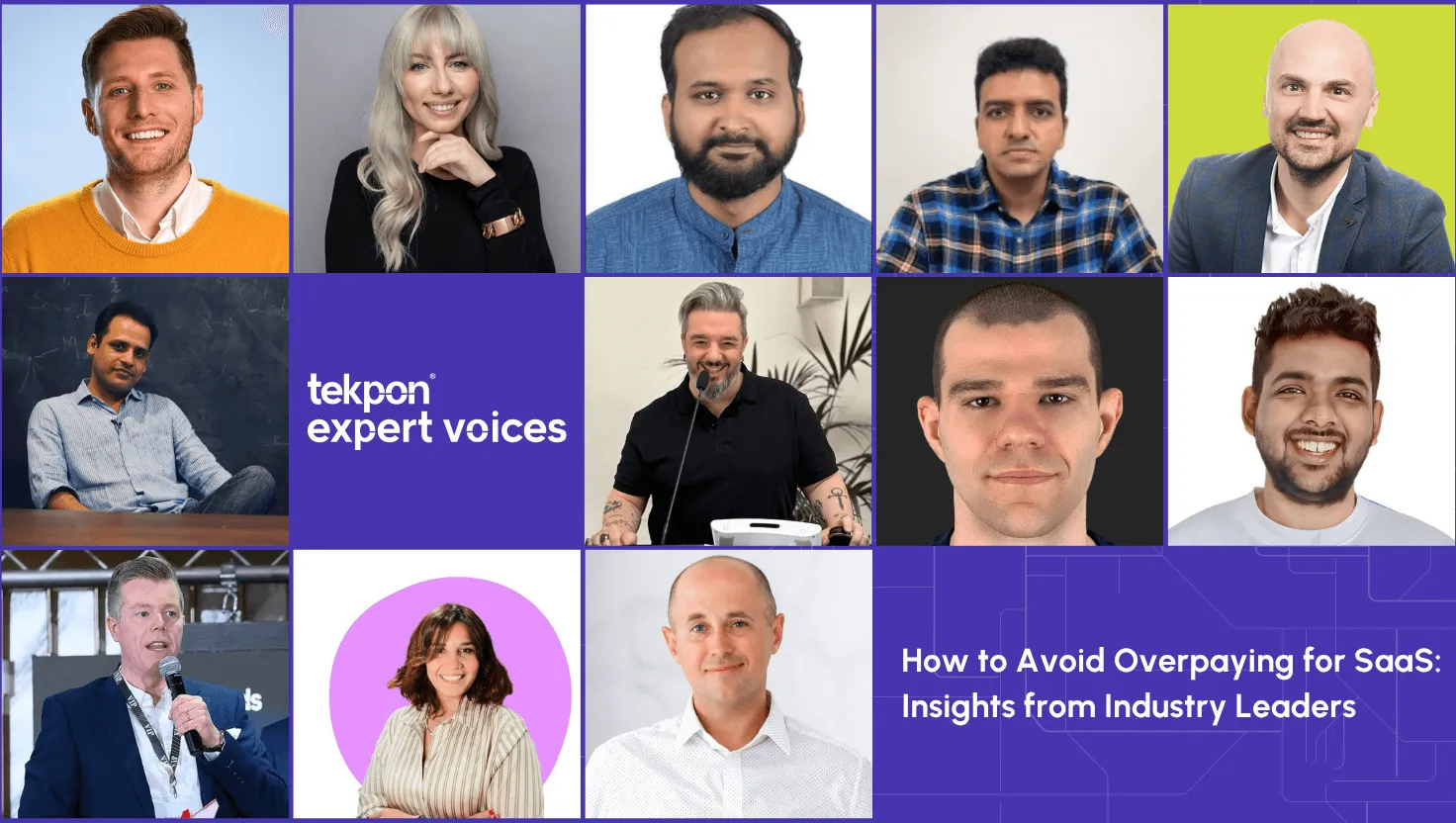How to Avoid Overpaying for SaaS: Insights from Industry Leaders

Table of Contents
- Leveraging AI for Content Creation
- Unconventional Cost-Cutting Strategies
- The Importance of Expert Implementation
- Visibility and Consolidation
- Focused Targeting and Attribution
- Strategic Spending
- Acting Like You’re Bootstrapping
- Getting the Most Out of Your SaaS Investments
- Radical Simplicity
- Stop Wasting Spend
- Expanding Low-Cost Acquisition Channels
- Optimizing RPE Ranges
- How I’ve Learned to Cut SaaS Spend
- Volume vs. High-Ticket SaaS
- Prioritize and Align with Business Objectives
- Think Smarter, Not Harder
- Review, Replace, and Build Internally
- Open Source and the Shift Toward Affordable SaaS
- Proactive Planning and Testing for Necessity
- Simple Tips to Save on SaaS
- Cutting SaaS Spend Without Hurting Growth
- Conclusion
Navigating the world of SaaS can feel like walking through a bustling marketplace where every vendor is eager to sell you the next big thing. It’s easy to get caught up in the excitement and end up with a cart full of tools that don’t quite fit your needs. We’ve seen it happen time and again, companies investing heavily in SaaS solutions, only to realize they’re not getting the value they expected.
That’s why we’ve reached out to some of the brightest minds in the industry to share their insights on how to make smarter, more strategic decisions about your SaaS investments. In this article, you’ll find practical advice and real-world strategies to help you cut through the noise and focus on what truly matters for your business.
Leveraging AI for Content Creation
Anton Voroniuk, CEO at SaaSBooster, highlights the significant cost-saving opportunities that AI presents for SaaS companies, particularly in content creation.

From my experience running a digital marketing agency and online education platforms like SkillsBooster and SaasBooster, one of the biggest cost-saving opportunities for SaaS companies today lies in content creation, especially through AI.
Many founders still see AI as something abstract or experimental, but we’ve seen a clear shift: forward-thinking SaaS teams are already leveraging tools like Heygen, ElevenLabs, Gamma App, and Trupeer to produce high-quality content faster and at a fraction of the traditional cost. This includes everything from website copy and social media creatives to educational videos featuring AI avatars.
In our own work creating courses for platforms like Udemy and Coursera, AI has dramatically reduced production time and budget. My advice to SaaS founders: stop treating AI as a trend, start using it systematically. Educate your models, integrate the tools, and you’ll not only save costs but gain a competitive edge in speed and consistency.
He says that AI can dramatically reduce production time and budget, advising SaaS founders to start using AI systematically to gain a competitive edge in speed and consistency.
Unconventional Cost-Cutting Strategies
Sampath S, Co-founder at SaaS Mantra, offers unconventional strategies for cutting SaaS costs that go beyond basic budgeting.

Most experts would advise you on cutting SaaS costs circles around audits and negotiations. But not me..
I’m sharing 3 unconventional strategies that move beyond basic budgeting and turn your whole team into savvy, empowered cost-cutters.. and instantly boost your profits for the year
(P.S You can combine them for maximum impact, or implement them individually, depending on the size of your business)
- 1. Run a 30-Day Tool-Free Challenge
Ask each department (or your whole company, if you’re a team of 10 or under) to go 30 days without any non-essential SaaS tools, i.e., without Emails
Tell teams to switch off project management apps, time trackers or email signature tools that aren’t mission-critical. What breaks? What actually matters?
You’ll be surprised.
In most cases, usage stats don’t tell the full story, a tool might look popular but is only marginally useful.
When it’s gone, does anyone really notice?
This challenge quickly separates the must-have, from the nice-to-have.
How to do it:
- List every tool your team uses.
- Assign “essential” and “optional” tags (BE STRICT!)
- Turn off the optional ones for a month
- After 30 days, gather feedback: what was missed, and what wasn’t?
If 30 days sound like a lot, try it for 7 or 14 days.
- 2. Barter or Partner With SaaS Companies
Next, take what you’ve learned from the challenge and get creative with your remaining stack.
If you found tools you can’t live without, but they’re pricey, don’t just accept the bill. Reach out to those vendors and offer something in return:
- Case studies
- Success Stories
- Video Testimonials
- Co-marketing opportunities
- (I can write all day long, but you got my point!)
- You might land discounted rates or free months in exchange for your contribution.
How to do it:
- Identify your most-used (and most expensive) tools post-challenge
- Contact their customer success or partnership teams
- Offer to write a testimonial, share their tool with your network, or participate in a joint webinar in return for discounts
- 3. Set Up an Internal SaaS Bounty
Now, make cost-cutting a company-wide game (works awesome if you are 50 or more).
Announce an internal “SaaS Bounty:” Reward any employee who spots an unused, redundant, or overpriced tool that can be eliminated or replaced.
Sometimes the best savings come from the people closest to work.
- Cash bonus
- Gift card
- Extra day off (Cost Effective)
- for every successful find that results in real savings.
PLUS, you’ll create a culture of ownership and vigilance instead of one person shouldering all the responsibility.
How to do it:
- – Publicize all active SaaS subscriptions internally.
- – Invite everyone to hunt for overlaps or low-usage tools.
- – Pay out small rewards for every valid cost-saving suggestion.
Putting It All Together
Start with the 30-day challenge to clear out the clutter and spotlight your “can’t live without” software.
For what remains, negotiate creatively through bartering or partnerships. Meanwhile, empower your entire team with a SaaS bounty to keep costs under control moving forward.
This three-step approach isn’t just about reducing spend, it’s about building a culture where every dollar works harder for your business. Try it, and watch your SaaS expenses shrink without sacrificing performance.
- BONUS:
There’s a special category for some SaaS tools that fall under the category of “Non-essential, but must-have”
Deploy your tech team to use AI tools, like Lovable, Bolt, etc. to build such tools
Sampath’s strategies focus on fostering a culture of cost awareness and empowerment, leading to significant savings and improved efficiency.
The Importance of Expert Implementation
Warrick Swift, Chief Marketing Officer at SINGU, discusses how poor adoption and fragmented implementation of SaaS tools can lead to overspending.

One of the biggest reasons companies overpay for SaaS isn’t always the price of the software itself, it’s poor adoption and fragmented implementation. Even the most feature-rich platform delivers limited value if teams aren’t using it effectively.
I’ve seen firsthand that when technology is deployed with clear onboarding, stakeholder alignment, and embedded into daily workflows, the time to value shrinks dramatically. SaaS only pays off when it’s used, understood, and integrated into how a company truly operates, not when it sits in a silo with a login no one touches.
To reduce costs, companies must regularly audit their tech stack and ask: are tools being used to their full potential? Are systems integrated and sharing data? Are stakeholders across departments actually leveraging the solution in their day-to-day roles?
At SINGU, we’ve learned that successful CAFM deployments come down to one thing, expert implementation. When software is aligned with real business needs, actively used, and part of a connected ecosystem, it doesn’t just save money, it drives real, lasting impact.
He emphasizes the importance of expert implementation to ensure that software is aligned with real business needs and actively used.
Visibility and Consolidation
Yevhen Zakharchenko, Fractional CFO, stresses the importance of visibility in managing SaaS spend.

To cut SaaS spend effectively, start with visibility. Most companies don’t know what tools are being used, by whom, and why.
Once you have that clarity, consolidate overlapping tools, eliminate unused licenses, and renegotiate contracts.
You’d be surprised how much is left on the table just because nobody’s tracking usage.
He advises companies to start by understanding what tools are being used and why, then consolidate overlapping tools and renegotiate contracts.
Focused Targeting and Attribution
Ryan James, Founder at Rocket SaaS, advises on the importance of focused targeting and attribution in SaaS marketing.

One of the biggest sources of wasted spend in SaaS is going too broad with your target audience. When you try to speak to everyone, you often end up converting no one, and paying a premium for the privilege.
Before scaling any campaign, the smartest investment is in research. Identify your Ideal Customer Profile (ICP), understand their pain points, and then narrow your targeting accordingly. Focused targeting not only reduces wasted impressions and clicks but often leads to better engagement and higher conversion rates.
Once your audience is clear, attribution data becomes your best tool for making confident decisions about where to cut or reinvest. It is not just about tracking vanity metrics like impressions or clicks. You need to understand which campaigns actually drive pipeline and revenue.
Use UTM tags consistently across all channels to track where your traffic is coming from and how each campaign performs. Layer on qualitative insights by adding a “How did you hear about us?” field to your contact forms. This small addition can help uncover influential touchpoints that might not show up in your analytics, like a podcast mention or a LinkedIn comment thread.
Attribution enables SaaS marketers to:
- Cut campaigns that drive traffic but not conversions
- Reallocate budget toward sources that produce qualified leads
- Identify high-performing content formats, messaging angles, and audiences
- Make faster, more informed decisions when testing new channels
With a solid attribution model and a focused ICP, you are not just reducing spend, you are making every pound work harder. That is the difference between cost-cutting and strategic optimisation.
Ryan’s insights highlight the importance of understanding which campaigns drive real value and making data-driven decisions to optimize spend.
Strategic Spending
Aravind S, Fractional CFO at SaaSBoomi, emphasizes the importance of strategic spending in today’s fast-paced business environment.

In today’s world, companies are racing to automate workflows to boost speed and efficiency by 20x.
Teams are encouraged to experiment freely, leading to tool duplications and forgotten subscriptions. Meanwhile, AI pricing remains uncertain, many face pushback due to market pressure and competition.
Instead of rushing to cut costs, it’s smarter to scrutinize spending more deeply. Bring transparency with spend management tools to monitor usage and renewals.
The goal isn’t to eliminate spend but to ensure it aligns with strategy, not convenience. When spend follows purpose, efficiency follows.
It’s good to note that “Smart spending isn’t about spending less; it’s about spending right.
He advises companies to scrutinize their spending deeply and bring transparency with spend management tools.
Acting Like You’re Bootstrapping
Isabel Reyes, Interim Head of Marketing at N.Rich, advises B2B SaaS companies to act like they’re bootstrapping, even if they’re not.

B2B SaaS companies often chase scale without first fixing the fundamentals. The smartest way to reduce costs is to act like you’re bootstrapping, even if you’re not.
Start by aligning marketing and sales around revenue outcomes, not activity.
Cut tools and campaigns that don’t tie back to pipeline contribution, and refocus efforts on channels that convert with intent.
Efficiency isn’t about spending les, it’s about making every move count.
She emphasizes the importance of aligning marketing and sales around revenue outcomes and cutting tools and campaigns that don’t contribute to the pipeline.
Getting the Most Out of Your SaaS Investments
Meenank Minnu shares insights on how to get the most out of your SaaS investments at different stages of business growth.
Let me teach you how to get the most out of your SaaS investments, no matter where your business is right now:
- Just Starting Out (Idea Stage)
When you’re just getting an idea off the ground, every penny counts.
Go Free First: Kick things off with free trials or open-source tools. This way, you can test the waters and figure out exactly what you need without spending a dime.
Ask for More Time: If a trial period isn’t quite enough, don’t be shy! Reach out to the SaaS company and ask for an extension. Most are happy to give you more time if they see you’re
genuinely interested.
- Early Days (0-1 Stage)
You’ve got your first customers, and you’re building momentum. Now’s the time to find smart deals.
Hunt for Lifetime Deals. You can often snag amazing lifetime deals on SaaS products. Just remember, some of these might still be in their early stages, so make sure they’re a good fit and stable enough for your needs.
Cash in on Startup Credits: Programs like AWS Activate and WeWork Labs offer fantastic startup credits. These can give you big discounts or even free access to essential tools as you get going.
- Growing Fast (1-10 Stage):
Your company is scaling, and you’re probably adding more and more tools.
Negotiate Annual Plans: When you’re ready to commit, opt for annual subscriptions. Then, get in touch with the customer success team and negotiate! Companies are often willing to offer better deals if you commit for a full year upfront.
Always Shop Around: There’s almost always another option out there. Don’t rush into a decision. Take your time to explore alternatives on sites like Product Hunt to make sure you’re
getting the best value for your money.
- A Final Thought:
No matter what stage you’re in, always stay on your toes. The SaaS world is constantly changing, with new deals and alternatives popping up all the time.
Take your time to do your research, negotiate, and make smart choices. Doing so can save your company thousands and help you build a stronger, more sustainable tech stack.
He advises starting with free trials, hunting for lifetime deals, and negotiating annual plans as the company scales.
Radical Simplicity
Batiste Pasquet, Founder at OLI, advocates for radical simplicity in managing SaaS tools.

The biggest SaaS spend mistake I see in startups is tool overload without actual adoption. We chase productivity, then drown in overlapping tools nobody really uses.
At OLI, we follow a principle I call ‘radical simplicity’: if a tool doesn’t directly improve the closing rate, speed up onboarding, or reduce admin time, we don’t use it.
We cut spend in three steps:
1. Audit by outcomes. Not just usage, but whether the tool helps us achieve specific outcomes (like shortening deal cycles or improving data hygiene).
2. Kill overlap early. If Slack, Notion, and Asana all serve as ‘project tools,’ we reduce to one. That’s saved us thousands.
3. Automate before you buy. We use lightweight AI automation to connect tools before paying for expensive integrations or onboarding software.
Most of the times, cutting SaaS isn’t about switching vendors, it’s about switching mindsets. If you can track (measure), iterate, and have a clear impact, there is no need.
He notes that startups often chase productivity but end up drowning in overlapping tools that nobody really uses.
Stop Wasting Spend
George Storm, Co-Founder at Break The Box, advises B2B SaaS companies to stop wasting spend by aligning headcount with pipeline reality and consolidating tools that drive activation.

Most B2B SaaS companies don’t need to cut spend, they need to stop wasting it. The biggest leak? Headcount misaligned with pipeline reality. If you’re hiring AEs without at least 3x coverage in qualified pipeline per rep, you’re not scaling. You’re inflating payroll. The fix isn’t more sellers. It’s better systems.
Before adding another SDR or AE, ask: Do we know our real win rate by segment? Do we have precision on outbound conversion by persona? If not, you’re funding chaos, not revenue.
Second, kill the tool sprawl. The average mid-market GTM team now uses 15 to 22 tools, many of which overlap or go underused. If 65 to 90 percent of sales content isn’t even touched by reps (Forrester), and over a third of marketing tech gets logged into less than monthly, what exactly are you paying for?
Consolidate on platforms that actually drive activation, not just visibility. Anything that doesn’t directly connect to revenue execution should be on the chopping block.
And finally: stop measuring marketing by volume and start measuring by efficiency. That means retiring the MQL hamster wheel and pushing toward GTM alignment.
Shared pipeline goals. Shared target account lists. Shared accountability. If CAC is up 45 percent and payback periods now stretch past 20 months, you can’t afford to fund activity that doesn’t directly tie to opportunity progression. Cut the noise. Double down on precision. Make spend serve strategy, not the other way around.
George’s approach ensures that companies focus on precision and make every dollar count.
Expanding Low-Cost Acquisition Channels
Jamie I.F., Founder at Endorsely, emphasizes the importance of expanding low-cost acquisition channels like affiliate marketing and influencer partnerships.

Many SaaS companies in 2025 remain over-reliant on paid advertising. While paid ads deliver results, they often come with significantly higher customer acquisition costs (CAC) versus other channels.
With our own brands Endorsely.com and AffiliateFinder.ai, we’ve discovered that recruiting affiliates and partnering with influencers converts user far cheaper than paid ads.
We offer a 30% affiliate commission for 12 months. If the average customer stays 2 years, that is a 6:1 LTV-to-CAC ratio. This substantially outperforms most paid advertising campaigns and creates a sustainable growth model.
Reducing SaaS costs isn’t solely about cutting tools or reducing headcount. Instead, expand your lowest-cost acquisition channels.
He notes that these channels often convert users far cheaper than paid ads.
Optimizing RPE Ranges
Joe Wheatley, Co-Founder & CEO at House Group, shares insights on optimizing Revenue Per Employee (RPE) ranges.

Here is my simple step by step strategy:
1. Define RPE Ranges: Set your RPE ranges for “firing,” “healthy,” and “hiring” based on company benchmarks and industry research.
2. Remove B and C Players: Remove all B- and C-players in your business to improve efficiency and raise RPE
3. Optimize A-Players: Empower your A-players with better tools, AI, and automation so they can do more with their time.
4. Identify Next Hire: Determine who your next right hire should be based onstrategic goals and skill gaps.
5. Act on RPE Signals:
If RPE drops below your healthy range → remove underperformers or redundant roles.
If RPE rises above your healthy range → make your next right hire to support growth.
If RPE is healthy → focus on optimizing output from your current team.
6. Repeat Steps 1–5.
He advises defining RPE ranges, removing underperformers, and empowering top performers with better tools and automation.
How I’ve Learned to Cut SaaS Spend
Divyaprasad Pande, VP of Marketing at Clodura.AI, shares his insights on cutting SaaS spend through regular audits, consolidating tools, leveraging benchmark data, establishing clear governance, and prioritizing spend based on ROI.

How I’ve Learned to Cut SaaS Spend 💡
- 1. Audit Everything: The Hidden Cost of Unused Seats
At Clodura.AI, where I’m leading the marketing, we performed a comprehensive audit and discovered nearly 30% of our SaaS licenses were sitting unused. This aligns with broader industry data, Zylo reports that approximately 51% of SaaS licenses are typically underutilized, leading to millions in unnecessary expenditure. A quarterly audit of finance and procurement records enabled us to immediately reclaim budgets and redirect them into growth initiatives.
- 2. Consolidate Overlapping Tools
In my previous role at Machintel Systems, our marketing stack had grown fragmented with multiple overlapping solutions for campaign management, analytics, and email automation. By consolidating tools, choosing HubSpot as our central marketing automation platform, we reduced costs by about 25% and significantly streamlined our internal processes. The impact was clear: improved efficiency, quicker onboarding, and better cross-team collaboration.
- 3. Leverage Benchmark Data During Negotiations
One of the most powerful tactics I learned at Clodura.AI was leveraging benchmark data during vendor negotiations. Equipped with this data, we successfully negotiated vendor renewals, cutting costs by 15–20% and securing better contract terms. Benchmarking gave us the confidence and leverage needed to optimize spend effectively.
- 4. Establish Clear SaaS Governance
Implementing clear governance policies at Clodura.AI ensured transparency around departmental SaaS spend. Monthly spend dashboards and executive sponsorship by finance and IT teams helped us detect and curb shadow IT proactively, reducing unintended expenses by another 10–15%.
- 5. Prioritize Spend Based on ROI
Not every SaaS tool is equally valuable. According to CloudZero, 58% of businesses feel their cloud and SaaS expenses are excessive. At Clodura.AI, we developed clear criteria—tools either had to directly increase revenue, substantially improve efficiency, or be essential for scalability. This strict ROI-focused approach naturally weeded out underperforming tools, allowing us to reinvest strategically in solutions driving real value.
Why This Approach Works
- Team Alignment: Cross-departmental transparency and accountability.
- Data-driven Decisions: Benchmarking ensures negotiations and renewals are competitive.
- Sustainable Savings: Regular audits and clear governance sustain ongoing cost efficiencies.
Reducing SaaS spend isn’t about compromising productivity, it’s about intelligent optimization. Drawing from over 12 years of SaaS marketing leadership, I’ve found these tactics indispensable for building leaner, more impactful SaaS stacks.
“The real secret to cutting SaaS spend sustainably is fostering a culture where teams proactively evaluate and challenge the necessity of each tool. At Clodura.AI, empowering teams to openly discuss and assess the effectiveness of their SaaS usage has led not just to cost savings, but also to greater ownership and accountability across the board.”
Divyaprasad’s approach ensures that companies can reclaim budgets, streamline processes, and make informed decisions about their SaaS investments.
Volume vs. High-Ticket SaaS
Andy emphasizes the importance of managing resources effectively and focusing on relationship building in high-ticket SaaS.

It depends if you are working in volume or high-ticket SaaS. With the former (volume), you are likely heavily dependent on Google ads as a source of signups. If budget cuts are on the table, you need to cut away inefficiencies. I can almost guarantee that you have some inefficiencies in your ad spend. Review all campaigns and try to do the (not so simple) exercise of understanding exactly which campaigns are delivering revenue. You should try get as granular as possible here; break it down to campaigns, ad groups, and keywords. Which of these are converting into revenue. Cut anything that’s not. You will see a cut in traffic, but unlikely a cut in revenue.
On the latter (high-ticket SaaS), you will need to review your budget line by line and see where you can cut the fat. The key to this type of SaaS is relationship building. It will be tempting to cut bigger line items like events, but instead of completely cutting, I would scale back. Instead of a 60m2 booth, go with the smaller option. Perhaps instead of a booth presence, you just send a few of the team. Look at areas that are nice to have and may not be well managed at the minute. Things like PR are usually terribly managed, and the likelihood is that you’re paying an agency a lot of money for something that’s not being used effectively.
Rule of thumb: if you don’t have the proper resource to manage something, cut it!
You will ultimately need to look at headcount here as well. One of the first things normally to go are SDRs. This, in my opinion, is lazy and uninformed. The SDR is the way into a prospect organization. They do the relationship build work that marketing campaigns can’t. They are most of the time seen as “not working” because they’re mismanaged. Focus on cutting back marketing spend to be more brand-focused, which is cheaper, and double down on enabling an outbound “attack” from your SDR team. This way you’re saving on cutting on campaigns AND making whatever you are doing the most effective it can be.
He advises against cutting SDRs and suggests doubling down on enabling an outbound “attack” from the SDR team to make marketing spend more effective.
Prioritize and Align with Business Objectives
Irina Verlan, MBA, CEE Cloud Marketing Manager and Customer Reference Manager at Google via Algomarketing, shares her insights on avoiding overspending for SaaS from a CMO’s perspective.
How to avoid overspending for SaaS (as a CMO): prioritize tools and automation strategies that align with your core business objectives (whatever they are: driving pipeline acceleration, optimizing customer journey, or scaling content).
If it doesn’t meet a business KPI, it’s a cost center, not an asset. Avoid setting goals that don’t align with the business KPIs. Consolidate one solution tool for multiple marketing tactics. Negotiate contracts. Always. Engage partnerships that ensure long-term collaboration, and go for an annual contract instead of a monthly subscription.
Adopt a data-savvy culture across your departments. Data = information = power = leads = beginning of a sales cycle.
Ensure your marketing team is trained on automation, negotiation, and data analytics. Spend smarter, not smaller: always track your budget.
She emphasizes the importance of prioritizing tools and automation strategies that align with core business objectives.
Think Smarter, Not Harder
Marek Mrazik, Founder & CEO of Kontentino.com and Allfred.io, emphasizes the importance of smart thinking over hard negotiation when it comes to cutting SaaS spend.
Cutting SaaS spend isn’t about negotiating harder, it’s about thinking smarter from the start.
I’ve been on both sides of the equation: running agencies frustrated with bloated, overpriced tool stacks, and now building lean SaaS products like Allfred.io and Kontentino. And honestly? Most teams overspend not because tools are expensive, but because they use five tools to do the job of one.
That’s why consolidation is the first step. At Allfred, we’ve helped agencies cut software costs by up to 50% just by replacing fragmented setups with one integrated system for project management, time tracking, finance, and resource planning.
Another underrated move? Get in early. Founders often reward early adopters with lifetime deals or generous legacy pricing. I’m still paying 7 bucks a month for Harvest — because I signed up in 2014.
And sometimes, the best tactic is… patience. Cancel a tool you’re not using and stay on their mailing list. You’d be surprised how many reactivation offers land in your inbox within weeks.
In my case, when tools felt overpriced or didn’t fit how we worked, I just built the thing we needed, and ended up selling it to others. That’s how both Kontentino and Allfred were born. So yeah, if a SaaS product frustrates you enough… maybe it’s a sign to build your own 😅
Bottom line: cutting SaaS spend isn’t about being cheap. It’s about aligning your stack with how your team actually works — and making every tool earn its keep.
With experience on both sides of the equation, Marek has seen firsthand how teams often overspend by using multiple tools to do the job of one.
Review, Replace, and Build Internally
Olga Mykhoparkina, Founder at Quoleady, shares her recent experience reviewing her team’s SaaS usage and discovering that many tools were either underused or redundant, especially with AI advancements.

It’s a timely question by the way as I’ve been reviewing our SaaS usage across the team recently and realized that a big chunk of the tools we pay for are either barely used or overlap with others we already have. With AI in the mix, it’s easy to buy a bunch of tools that essentially solve the same problem.
For example, we’re paying for GSuite, and I realized it could replace Zoom, Read.ai, and even Calendly with it. Google Meet works better for us than Zoom. Gemini now takes notes and sends AI summaries after calls. Calendly is the only one we haven’t fully replaced yet – we’re still waiting on a couple of missing workflows in Google’s appointment scheduling tool. Once those are there, I’m happy to switch. CoSchedule – with LinkedIn scheduling feature in place, I realized I no longer need it as I’ve been using it only for LinkedIn posts.
The point is: keep an eye on tool updates. As they roll out more features, it often turns out you no longer need 3 tools – one can cover the whole workflow. At the same time, vendors are using AI as a reason to raise prices (like GSuite did with Gemini), so it’s even more important to review usage and overlap regularly.
I’ve also started building a few internal micro tools at Lovable that replicate what some paid SaaS products do. In some cases, they’re a much better fit – and we don’t need to keep paying for yet another subscription.
Her key takeaway? Stay vigilant, consolidate where possible, and don’t hesitate to build your own solutions when it makes sense.
Open Source and the Shift Toward Affordable SaaS
Nick Franklin, Founder & CEO at ChartMogul, shares how his company has found significant efficiencies by transitioning to open-source alternatives
Like many SaaS companies we’ve been looking to find efficiencies in our own SaaS and cloud spending over the past couple of years.
We’ve had the most luck moving to open source solutions, e.g. we moved from Snowflake to ClickHouse, and from Segment to Jitsu, both times we saw considerable savings, we even wrote about our migration to Jitsu here https://chartmogul.com/blog/more-control-less-spend-cdp/.
The general trend in SaaS is towards higher quality and lower priced software, with that in mind we also recently introduced new, more affordable pricing plans of our own to get ahead of this new reality.
Every SaaS vendor out there is living on borrowed time if they don’t adapt to this new reality. Buyers are expecting tonnes of value, highly polished solutions, and at lower prices. The days of being able to charge tens of thousands of dollars for straightforward workflow apps will soon be over.
His advice? Explore open-source alternatives and stay ahead of pricing trends to ensure your SaaS stack remains cost-effective and future-proof.
Proactive Planning and Testing for Necessity
Simon Ritchie, Founder & CEO at Blox, emphasizes the importance of proactive planning and testing for necessity when managing SaaS spend.
My top advice for cutting SaaS spend revolves around proactive planning and Testing for Necessity:
1. Plan Your Spending, Don’t React to Impulse: Hopefully you have a planning and budgeting process. If a new SaaS solution isn’t already accounted for in your financial plans, then take a quick moment to pause and assess its necessity. Impulse purchases or adding tools “out of cycle” often lead to redundancy and wasted spend. Blox helps companies gain crystal-clear visibility into their planned vs. actual expenses, making it easy to identify and control these off-plan outlays.
2. Leverage Virtual Cards and Test for Necessity: For recurring subscriptions, I highly recommend using a platform that offers virtual cards. Set up separate virtual cards for different SaaS vendors or teams. Don’t be afraid to occasionally “freeze” or pause these virtual cards to see what services truly matter. If your team members don’t complain when a service isn’t paid for or is temporarily unavailable, it’s a strong indicator that you’re likely paying for software you don’t actually need, or that’s significantly underutilised. This tactic forces a natural audit process.
He advises companies to avoid impulse purchases and ensure that every new tool aligns with their financial plans.
Simple Tips to Save on SaaS
Rajesh D, Founder at OnSefy, offers practical, actionable tips to avoid overpaying for SaaS.

SaaS means Software as a Service – tools like Zoom, Canva, Notion, Salesforce, etc. You pay monthly or yearly and use them online. Many people end up paying more than needed. Here are some simple tips to help you save money and avoid overpaying.
1. Use Free Plan First
Before buying any plan, check if the free version is enough for your needs. Many SaaS tools offer free plans with good features.
Example: Canva, Notion, Mailchimp – their free plans work well for small teams or solo users.
2. Don’t Buy Yearly Plans Too Early
Most SaaS tools give discounts on yearly payment, but don’t rush. Try the monthly plan first. If you like it after 1-2 months, then upgrade to yearly.
This way you avoid wasting money on something you may not continue using.
3. Track What You Are Paying For
Many people forget which tools they are paying for. Use a simple Excel sheet or reminder app to track:
• Tool name
• Amount
• Renewal date
• Cancel any tool you’re not using regularly.
4. Reduce Unused Team Accounts
If a SaaS tool charges per user, check how many people are really using it. If only 2 out of 5 are active, remove the extra users.
This can reduce your monthly bill by 30–50%.
5. Ask for Discounts
Yes, you can ask! Many SaaS companies give discounts if you ask via chat or email. Especially if you are:
• A startup
• A student
• Coming from a competitor
Just say:
“Do you have any special offer or discount available?”
6. Check Alternatives Before Buying
Before paying, check if there is a cheaper tool that does the same job. Google it or ask in online forums like Reddit or LinkedIn.
Sometimes you’ll find a $20/month tool doing the same thing as a $50/month one.
7. Be Careful with Auto-Renewals
Most SaaS tools renew automatically. If you forget, money will be deducted. To avoid this:
• Set calendar reminders
• Turn off auto-renew if not needed
• Pay using cards with limits (optional trick)
8. Watch for Lifetime Deals
Some websites offer lifetime access to SaaS tools at one-time prices. Good for small business owners and freelancers.
Check websites like AppSumo, PitchGround, etc.
But do research before buying.
Final Tip: Review Every 3 Months
Every 3 months, sit for 10 minutes and ask:
• Am I using this tool?
• Is there a cheaper option?
• Can I share one account with my team?
This small habit can save you thousands every year.
His advice is rooted in common-sense strategies that anyone can implement.
Cutting SaaS Spend Without Hurting Growth
Casper Emil Sciuto Rouchmann, Founder at SparkForce, warns against short-sighted cost-cutting that can harm revenue generation.

Here is how I’d cut SaaS spend (without burning the whole thing down)
First rule?
Don’t let your CFO make the call alone without understanding the go-to-market motion first.
I’ve seen this too many times:
Tools get slashed, teams lose core workflows and six months later, everyone’s wondering why pipeline dried up.
So here’s how I’d actually do it:
1. Start with revenue analytics
– What campaigns are influencing pipeline?
– Which tools support them?
– Where do deals originate, and what touchpoints move them forward?
2. Ask: “Would I buy this tool again today?”
Forget what you’ve paid already.
If this tool vanished tomorrow, would you fight to get it back?
If not, cut it.
3. Then map tools to actual business outcomes
Is this tool moving revenue? Helping close deals? Improving retention?
Or just a “nice to have”?
If the answer’s the latter, time to say goodbye.
4. Don’t touch the GTM engine (unless you want to stall)
Killing the tools that drive awareness, leads, and conversion is like pulling spark plugs to save fuel.
Looks lean on paper, but now nothing’s moving.
5. Work with your reps
Most teams never ask sales what’s actually helping them sell.
Consolidate tools that overlap and kill off anything not adopted.
There’s no value in maintaining licenses for tools that never leave the drawer.
Cutting SaaS spend isn’t hard. Cutting it without hurting growth is where most teams screw it up.
But done right, it’s a forcing function.
He stresses the importance of understanding go-to-market (GTM) motion before making cuts.
Conclusion
As we’ve journeyed through the insights and experiences shared by these industry leaders, one thing becomes clear: optimizing your SaaS spending isn’t just about cutting costs, it’s about making thoughtful, informed choices that align with your business goals. It’s about fostering a culture of accountability and continuously evaluating the tools and strategies that drive real value.
We hope the advice and strategies shared here will inspire you to take a closer look at your own SaaS investments and make the necessary adjustments to ensure you’re getting the most out of every dollar spent. Remember, the goal isn’t to have the most tools, but to have the right tools that empower your team and drive your business forward.






